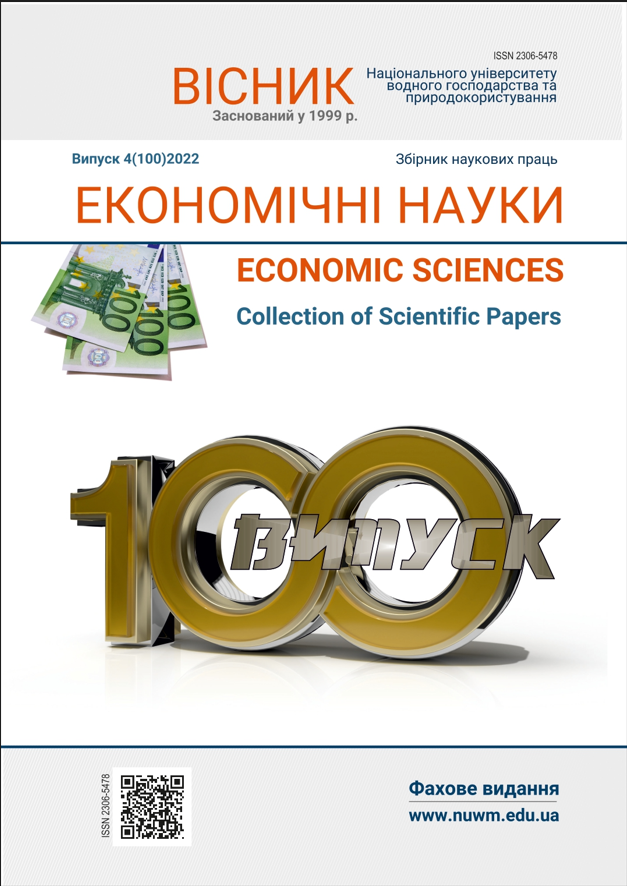LIQUIDITY, BUSINESS ACTIVITY AND PROFITABILITY: CHARACTERISTICS AND FEATURES OF DETERMINING INDIVIDUAL INDICATORS
DOI:
https://doi.org/10.31713/ve4202211Keywords:
liquidity, business activity, profitability, financial condition.Abstract
The article examines the economic essence of the financial state of the enterprise. The interpretation of this concept by various scientists is considered. Own identification of the essence of the defined economic category is formed. Under the financial condition it is proposed to understand the key characteristic of the effectiveness of the enterprise’s economic activity, which illustrates its competitiveness on the market, evaluates the available potential and the ability to settle short-term andlong-term obligations.The economic content of indicators of liquidity, business activity and profitability is highlighted. It was established that liquidity indicators are used to assess the company’s ability to fulfill short-term obligations. Analysis of the company’s liquidity plays an important role in characterizing its financial condition. Liquidity is the main factor that determines the degree of risk of investments in current assets.Analysis of business activity is carried out on the basis of methods that differ in the composition of indicators – qualitative or quantitative. It was determined that the analysis of business activity is traditionally carried out by the enterprise to identify problematic and unresolved issues that lead to its unstable activity.At the same time, profitability ratios are important indicators in the current planning of production, as well as in determining the financial condition of the enterprise. The main external factors that have a positive impact on the profitability of the enterprise are identified. The main external factors that have a positive impact on the profitability of the enterprise include: maintaining the hryvnia exchange rate and customs tariffs; significant expansion of the domestic market. implementation of an effective banking policy through the reduction of interest rates on loans and the creation of reliable mechanisms for refinancing production activities; reducing the tax burden on enterprise. Internal factors of increasing profitability are subjective, because the company can directly influence them. These factors include a set of actions and measures that willcontribute to increasing the efficiency of the enterprise.The dynamics of the specified indicators for the business entity – PE «DeLiss» for 2020–2021 are analyzed. After conducting an analysis of the profitability of PE «DeLiss» it was established that the enterprise demonstrated a low level of efficiency in conducting business activities. To ensure the growth of profitability, it is necessary to rationalize the costs of production and sale of products, increase labor productivity, establish a sales system, and improve the management of product quality and competitiveness.References
Денисенко М. П., Зазимко О. В. Основні аспекти оцінки фінансового стану підприємств. Агросвіт. 2015. № 10. URL: http://www.agrosvit.info/pdf/10_2015/10.pdf (дата звернення: 01.09.2022).
Пітінова А. О. Комплексна оцінка фінансового стану підприємства: сутність і необхідність. Економічні науки. 2013. № 4. С. 379–389.
Базілінська О. Я. Фінансовий аналіз: теорія та практика : підручник. Київ : Центр учбової літератури, 2012. 328 с.
Коробов М. Я. Фінансово-економічний аналіз діяльності підприємств: підручник. Київ : Знання, 2006. 378 с.
Савицька Г. В. Економічний аналіз діяльності підприємства : підручник. 2-е вид., випр. і доп. Київ : Знання, 2005. 662 с.
Фінанси підприємств : підручник / А. М. Поддєрьогін, М. Д. Білик,
Л. Д. Буряк та ін. ; 8 ме вид., перероб. та допов. Київ : КНЕУ, 2013. 520 с.
Фінансовий аналіз : навч. посіб. / М. Д. Білик, О. В. Павловська, Н. М. Притуляк, Н. Ю. Невмержицька. К. : КНЕУ, 2009. 592 с.
Чепка В. В., Свідерська І. М., Гавриленко Ю. О. Фінансовий стан підприємства: теоретичні основи. Інвестиції: практика та досвід. 2020. № 19–20. С. 96–102.
Бодруг Т. М. Сутність аналізу та управління фінансовим станом підприємств України. Науковий вісник Ужгородського національного університету. 2018. № 22. С. 20–24.
Аналіз ліквідності і платоспроможності підприємств. URL:
https://pns.hneu.edu.ua/pluginfile.php/261648/mod_resource/content/0/tema_7/Tema_7.pdf (дата звернення: 01.09.2022).
Чемчикаленко Р. А., Майборода О. В., Дьякова Ю. Ю. Напрямки підвищення ефективності оцінки ліквідності та платоспроможності підприємства. Економіка та суспільство. 2017. № 12. С. 642–648.
Барановська Т. В. Економічний аналіз : навч. посіб. Житомир : ПП «Рута», 2003. 680 с.
Тютюнник Ю. М. Фінансовий аналіз : навч. посіб. Полтава : ПДАА, 2016. 432 с.
Клименко В. С. Методика оцінки платоспроможності та ліквідності
підприємства. URL: file:///C:/Users/Acer/Downloads/7.pdf (дата звернення: 01.09.2022).
Польова Т. В., Кравцова Ю. В. Аналіз ліквідності балансу підприємства на прикладі ПРАТ «БОНДАРІВСЬКЕ». URL: file:///C:/Users/Acer/Downloads/35.pdf (дата звернення: 01.09.2022).
Соловей Н. В., Гудима В. Ю. Аналіз ділової активності підприємства як основа підвищення ефективності його діяльності. URL:
https://molodyivchenyi.ua/index.php/journal/article/view/2003/1981 (дата звернення: 01.09.2022).
Коляденко І. І., Кавтиш О. П. Аналіз ділової активності підприємства як основа підвищення ефективності його діяльності. URL: file:///C:/Users/Acer/Downloads/SPEP-20_p248-256%20(1).pdf (дата звернення: 01.09.2022).
Фаріон В. Я. Аналітична оцінка ділової активності та рентабельності підприємств. Інноваційна економіка. 2013. № 10. C. 27–33.
Бержанір І. А., Гвоздєй Н. І., Улянич Ю. В. Рентабельність як основний показник оцінки діяльності підприємства. URL:
https://dspace.khadi.kharkov.ua/dspace/bitstream/123456789/6422/1/piprp_2015_1%282%29__13.pdf (дата звернення: 01.09.2022).
Павелко О. В. Фінансові результати основної діяльності будівельних підприємств: організаційнометодологічні засади обліку : монографія. Рівне : НУВГП, 2020. 604 с. URL: https://ep3.nuwm.edu.ua/20055/ (дата звернення: 02.09.2022).
Дзюбенко О. М. Підходи до економічного аналізу рентабельності лісогосподарських підприємств. Вісник ЖДТУ. Сер. Економічні науки. 2018. № 1 (83). С. 9–14.
Ребрик М. І., Кирич Н. Б. Шляхи підвищення рівня рентабельності діяльності підприємства. URL: https://elartu.tntu.edu.ua/bitstream/lib/27681/2/VII_AZST_2018v3_Rebryk_M_IWays_of_increasing_the_223-224.pdf (дата звернення: 01.09.2022).

